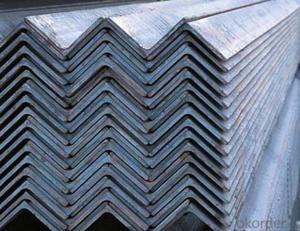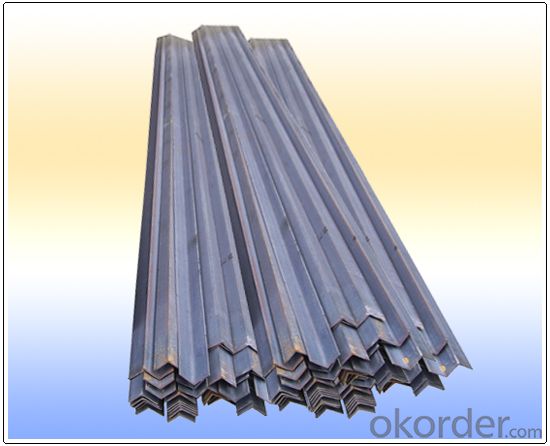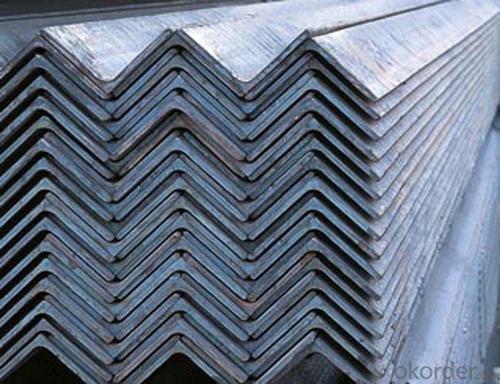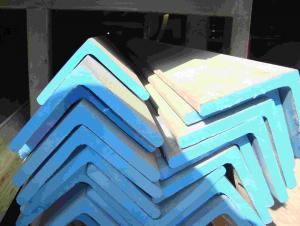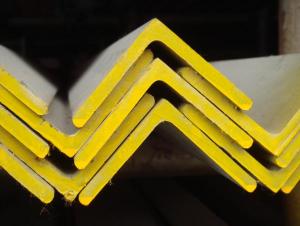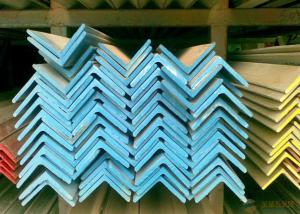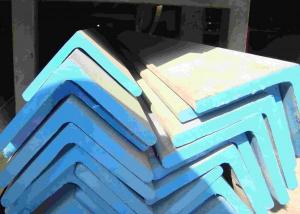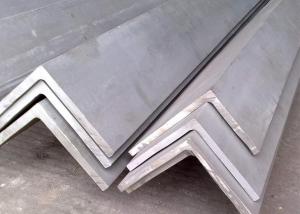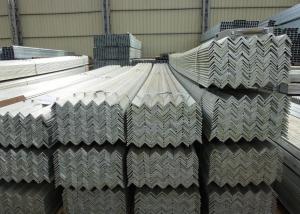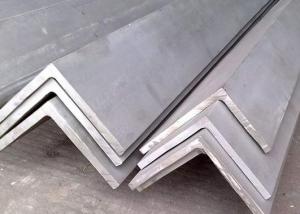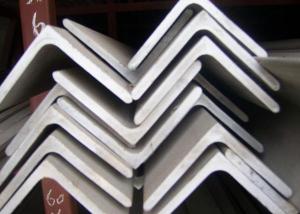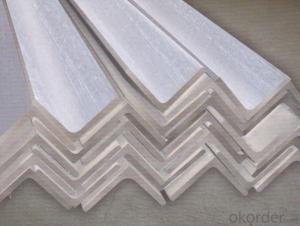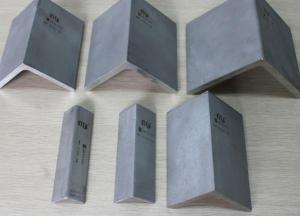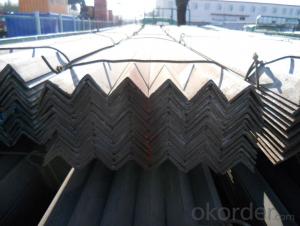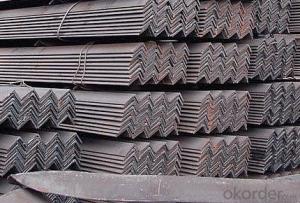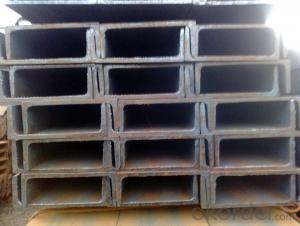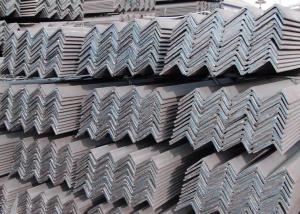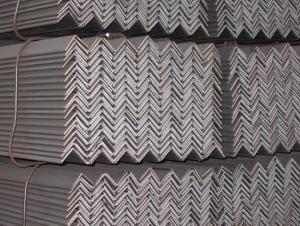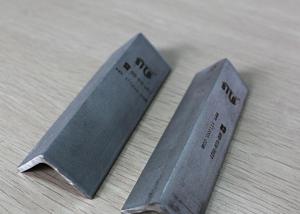stainless steel angle with customized size
- Loading Port:
- Qingdao
- Payment Terms:
- TT OR LC
- Min Order Qty:
- 10 m.t.
- Supply Capability:
- 5000 m.t./month
OKorder Service Pledge
Quality Product, Order Online Tracking, Timely Delivery
OKorder Financial Service
Credit Rating, Credit Services, Credit Purchasing
You Might Also Like
stainless steel angle
1.Grade:Q195-Q420
2.Surface:Bright,Polished,Turn smooth(Peeled),Brush,Mill,Pickled
3.Length:According to client's requirement ,it is from 3m to 6m
4.Size: Angle bar size from 10mm*10mm*2mm to to 400mm*400mm*16mm
5.Use:These products are widely supplied to areas of machine-made industry,chemical industry,spin,shipping industry,architecture,food industry,household products etc
6.ISO9001:2008
stainless steel angle | |||||||
| Size | Width (mm | Thicknessmm) | Density (kg/m) | Size | Width (mm | Thicknessmm) | Density (kg/m) |
| 20 | 20 | 3 | 0.889 | 80 | 80 | 7 | 8.525 |
| 20 | 20 | 4 | 1.145 | 80 | 80 | 8 | 9.658 |
| 25 | 25 | 3 | 1.124 | 80 | 80 | 10 | 11.874 |
| 25 | 25 | 4 | 1.459 | 90 | 90 | 6 | 8.35 |
| 30 | 30 | 3 | 1.373 | 90 | 90 | 7 | 9.656 |
| 30 | 30 | 4 | 1.786 | 90 | 90 | 8 | 10.946 |
| 35 | 35 | 3 | 1.578 | 90 | 90 | 10 | 13.476 |
| 35 | 35 | 4 | 2.072 | 90 | 90 | 12 | 15.94 |
| 35 | 35 | 5 | 2.551 | 100 | 100 | 6 | 9.366 |
| 40 | 40 | 3 | 1.852 | 100 | 100 | 7 | 10.83 |
| 40 | 40 | 4 | 2.422 | 100 | 100 | 8 | 10.276 |
| 40 | 40 | 5 | 1.976 | 100 | 100 | 10 | 15.12 |
| 44 | 44 | 3 | 2.002 | 100 | 100 | 12 | 17.898 |
| 44 | 44 | 4 | 2.638 | 100 | 100 | 14 | 20.611 |
| 38 | 38 | 3 | 1.719 | 100 | 100 | 16 | 23.257 |
| 38 | 38 | 4 | 2.261 | 110 | 110 | 7 | 11.928 |
| 48 | 48 | 3 | 2.19 | 110 | 110 | 8 | 13.532 |
| 48 | 48 | 4 | 2.889 | 110 | 110 | 10 | 16.69 |
| 48 | 48 | 5 | 3.572 | 110 | 110 | 12 | 19.782 |
| 50 | 50 | 3 | 2.332 | 110 | 110 | 14 | 22.809 |
| 50 | 50 | 4 | 3.059 | 125 | 125 | 8 | 15.504 |
| 50 | 50 | 5 | 3.77 | 125 | 125 | 10 | 19.133 |
| 50 | 50 | 6 | 4.465 | 125 | 125 | 12 | 22.692 |
| 56 | 56 | 3 | 2.624 | 125 | 125 | 14 | 26.193 |
| 56 | 56 | 4 | 3.446 | 140 | 140 | 10 | 21.488 |
| 56 | 56 | 5 | 4.251 | 140 | 140 | 12 | 25.522 |
| 56 | 56 | 6 | 6.568 | 140 | 140 | 14 | 29.49 |
| 63 | 63 | 4 | 3.907 | 140 | 140 | 16 | 33.393 |
| 63 | 63 | 5 | 4.822 | 160 | 160 | 10 | 24.724 |
| 63 | 63 | 6 | 5.721 | 160 | 160 | 12 | 29.391 |
| 63 | 63 | 8 | 7.469 | 160 | 160 | 14 | 33.987 |
| 63 | 63 | 10 | 9.151 | 160 | 160 | 16 | 38.518 |
| 70 | 70 | 4 | 4.372 | 180 | 180 | 12 | 33.159 |
| 70 | 70 | 5 | 5.397 | 180 | 180 | 14 | 35.383 |
| 70 | 70 | 6 | 6.406 | 180 | 180 | 16 | 43.452 |
| 70 | 70 | 7 | 7.398 | 180 | 180 | 18 | 48.634 |
| 70 | 70 | 8 | 8.373 | 200 | 200 | 14 | 42.894 |
| 75 | 75 | 5 | 5.818 | 200 | 200 | 16 | 48.56 |
| 75 | 75 | 6 | 6.905 | 200 | 200 | 18 | 54.501 |
| 75 | 75 | 7 | 7.976 | 200 | 200 | 20 | 60.056 |
| 75 | 75 | 8 | 9.03 | 200 | 200 | 22 | 71.168 |
| 75 | 75 | 10 | 11.089 | Length=6-12meters SS400 or Q235 | |||
| 80 | 80 | 5 | 6.211 | ||||
| 80 | 80 | 6 | 7.376 | ||||
- Q: Can stainless steel angles be used in the construction of curtain walls?
- Yes, stainless steel angles can be used in the construction of curtain walls. Stainless steel is a versatile and durable material that is commonly used in various construction applications. It offers numerous benefits such as high strength, corrosion resistance, and aesthetic appeal. Stainless steel angles can provide structural support and stability to curtain walls, which are vertical building envelope systems that are typically made of glass and metal frames. The angles can be used to connect curtain wall panels, create mullions, or reinforce the overall structure. Additionally, stainless steel angles can be customized to meet specific design requirements and architectural aesthetics. Overall, stainless steel angles are a suitable choice for curtain wall construction due to their strength, durability, and ability to withstand environmental factors.
- Q: Are stainless steel angles resistant to high temperatures?
- Yes, stainless steel angles are generally resistant to high temperatures. Stainless steel is known for its ability to withstand high heat without losing its strength or becoming deformed. This is due to the presence of chromium in the steel, which forms a protective oxide layer that prevents corrosion and oxidation at elevated temperatures. Stainless steel angles are commonly used in applications where high temperatures are encountered, such as in industrial furnaces, heat exchangers, and power plants. However, the specific temperature range that stainless steel can withstand without any significant damage depends on the grade of stainless steel and the duration of exposure to high temperatures.
- Q: Are stainless steel angles suitable for the production of bus shelters?
- Indeed, the utilization of stainless steel angles is appropriate for the fabrication of bus shelters. Given its exceptional durability and resistance to corrosion, stainless steel emerges as the perfect material for outdoor structures like bus shelters, which are constantly exposed to different weather conditions. By incorporating stainless steel angles, the structure gains both strength and stability, guaranteeing its long-lasting endurance against the elements. Moreover, stainless steel possesses an appealing and contemporary appearance, rendering it a favored option in architectural contexts, including bus shelters.
- Q: How do you calculate the deflection of a stainless steel angle?
- To calculate the deflection of a stainless steel angle, you need to consider the material's properties and the applied load. The deflection is a measure of how much the angle bends or deforms under the applied load. The first step is to determine the moment of inertia (I) of the stainless steel angle cross-section. This value represents the resistance of the angle to bending. The moment of inertia depends on the shape and size of the angle, and it can be calculated using mathematical formulas or obtained from engineering handbooks or online resources. Next, you need to determine the applied load (F) that is causing the deflection. This could be a force or a moment acting on the angle. The load can be determined from the specific application or by analyzing the structural requirements. Once you have the moment of inertia and the applied load, you can use the beam deflection equations to calculate the deflection. The most common equation used is the Euler-Bernoulli beam equation: δ = (F * L^3) / (3 * E * I) Where: δ is the deflection F is the applied load L is the length of the angle E is the modulus of elasticity of stainless steel I is the moment of inertia of the angle cross-section By plugging in the appropriate values into the equation, you can calculate the deflection of the stainless steel angle. It is important to ensure that the units of all variables are consistent to obtain accurate results. It's worth noting that this calculation assumes linear elastic behavior of the stainless steel angle. If the load exceeds the material's elastic limit, plastic deformation will occur, and a different analysis would be required. Additionally, more complex loading scenarios, such as distributed loads or varying moments, may require more advanced analysis techniques.
- Q: What are the chemical resistance properties of stainless steel angle?
- Stainless steel angle has excellent chemical resistance properties due to its high chromium content, which forms a protective oxide layer on the surface. This oxide layer prevents corrosion and makes stainless steel angle resistant to various chemicals, including acids, bases, and many organic compounds.
- Q: Are stainless steel angles resistant to scaling at high temperatures?
- Yes, stainless steel angles are resistant to scaling at high temperatures due to their composition, which includes a high percentage of chromium. The chromium forms a protective oxide layer on the surface of the steel, preventing oxidation and scaling even at elevated temperatures.
- Q: What are the different surface finishes available for stainless steel angle?
- Some of the different surface finishes available for stainless steel angle include mill finish, brushed finish, mirror finish, and powder-coated finish.
- Q: How do stainless steel angles contribute to the overall cost-effectiveness of a structure?
- In several ways, stainless steel angles contribute to the overall cost-effectiveness of a structure. To begin with, their long lifespan and low maintenance requirements help to reduce ongoing costs for repairs and replacements. Unlike other materials, stainless steel angles are highly resistant to corrosion, rust, and staining, making them durable and reliable over time. Moreover, stainless steel angles exhibit excellent strength-to-weight ratios, enabling them to provide structural support while using less material. This not only reduces the overall weight of the structure but also lowers material costs, resulting in greater cost-effectiveness. Furthermore, stainless steel angles have high load-bearing capacities, allowing for the construction of lighter and more streamlined structures, which can lead to savings in both material and construction costs. Additionally, stainless steel angles offer great versatility and can be easily fabricated, shaped, and welded to meet specific design requirements. This flexibility eliminates the need for additional components or complex joining methods, leading to reduced labor and installation costs. The ease of installation also accelerates the construction process, resulting in time savings and potential cost reductions. Furthermore, stainless steel angles exhibit excellent resistance to extreme temperatures, fire, and harsh weather conditions, making them suitable for both indoor and outdoor applications. This durability ensures that the structure maintains its integrity and functionality over time, reducing the need for expensive repairs or replacements in the long run. Finally, stainless steel angles are eco-friendly and sustainable. They are entirely recyclable, meaning they can be repurposed or reused at the end of their life cycle, minimizing waste and reducing the environmental impact. This commitment to sustainability not only aligns with global environmental goals but also helps to decrease costs associated with waste management and disposal. In conclusion, incorporating stainless steel angles into a structure offers numerous cost-saving benefits, including reduced maintenance and repair costs, lower material and construction expenses, faster installation, and long-term durability. With their versatility, strength, and sustainability, stainless steel angles represent a cost-effective solution that ensures the longevity and efficiency of any structure.
- Q: What are the different types of bending processes for stainless steel angles?
- There are several different types of bending processes that can be used for stainless steel angles. 1. Roll Bending: This process involves passing the stainless steel angle through a set of rollers to gradually bend it into the desired shape. Roll bending is commonly used for large-scale production and can achieve precise and consistent bends. 2. Press Brake Bending: In this method, a press brake machine is used to apply force to the stainless steel angle, causing it to bend. This process allows for greater control and flexibility in achieving different angles and shapes. 3. Induction Bending: Induction bending utilizes heat and force to bend the stainless steel angle. The angle is heated using an induction coil, and then pressure is applied to shape it into the desired form. Induction bending is often used for large and heavy stainless steel angles. 4. Rotary Draw Bending: This technique involves clamping the stainless steel angle into a machine and using rotating tools to gradually bend it. Rotary draw bending is known for its precision and is commonly used for small-scale production. 5. Mandrel Bending: Mandrel bending uses a mandrel or a flexible insert to support the inside of the stainless steel angle during the bending process. This ensures that the angle maintains its shape and integrity, especially when dealing with tight bends or small radii. Each bending process has its advantages and is suitable for different applications. The choice of the bending method will depend on factors such as the desired angle, the thickness of the stainless steel, production volume, and the required precision.
- Q: What is the maximum weight capacity of stainless steel angles?
- The maximum weight capacity of stainless steel angles depends on various factors such as the dimensions of the angle, the grade of stainless steel used, and the specific application or use case. Generally, stainless steel angles have high tensile strength and load-bearing capabilities, making them suitable for heavy-duty applications. However, it is essential to consult engineering specifications or reference materials provided by manufacturers to determine the exact maximum weight capacity for a specific stainless steel angle.
Send your message to us
stainless steel angle with customized size
- Loading Port:
- Qingdao
- Payment Terms:
- TT OR LC
- Min Order Qty:
- 10 m.t.
- Supply Capability:
- 5000 m.t./month
OKorder Service Pledge
Quality Product, Order Online Tracking, Timely Delivery
OKorder Financial Service
Credit Rating, Credit Services, Credit Purchasing
Similar products
Hot products
Hot Searches
Related keywords

